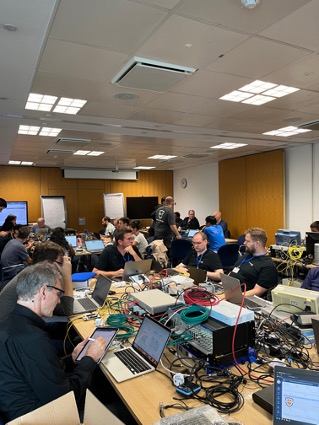Five Minute Facts about Packet Timing
After three years off for the pandemic, which felt like thirty, the ISPCS has been meeting in person again. In Vienna in 2022, London in 2023, and this year it will be in Tokyo in October. The ISPCS is the International Symposium on Precision Clock Synchronization. It’s a workshop on precise time and time distribution. The presentations are technical – engineer to engineer, equations welcome, fancy graphics optional. If this is your cup of tea, then come share a cup of tea with us next October in Tokyo.
Did you say that you are just trying to get your timing appliance working? Even more reason to participate because meeting in person again means holding the ISPCS PTP Plugfest. Everyone brings their PTP capable products, prototypes, or experiments and we connect them together and try to break your design. Break in a fun, collaborative environment so that it doesn’t break in your customer’s critical infrastructure. The first two days of the ISPCS will be the Plugfest.
Last year in London, actually Teddington England, the plugfest and symposium were held at the National Physical Laboratory, which is the national metrology laboratory for the UK. Part of the Plugfest room can be seen in Figure 1.

We built four networks to test Telecom, Power, Broadcast, Industrial and High Accuracy PTP Profiles (including a PRP network). After testing basic interoperability, we expose our devices to situations that test their robustness. This includes:
- Rogue timeTransmitters: Devices that should not be sending Sync and Announce messages, but they are.
- Wrong profiles traffic
- Simulated network congestion
- Leap seconds (using GNSS simulator
- Negative leap seconds! (Hey if the earth’s rotation continues to accelerate, this could happen. Are you ready?)
Plus, the chance for your devices to be tested one on one with Test equipment manufacturers application engineers. Vendors such Calnex Solutions, Safran’s GNSS simulators and others.
These circumstances tend to bring out bugs, such as the fact that the Linux kernel can’t properly handle a negative leap second. Not all of the issues come to my attention. Sometimes I just see that engineers from company X look very concerned but swear everything is fine. Here are some issues I did see:
- Incompatibilities between PTPv2 (IEEE 1588-2008) and PTPv2.1 (IEEE 1588-2019). The common PTP message header in PTPv2 had several reserved fields. These are fields that are reserved for future use by the IEEE 1588 Working Group. An implementation is supposed to set them to zero upon transmit, but not drop them if they are non-zero on receipt. The purpose of these fields is for the Working group to fix protocol issues or add features using these fields without breaking backward compatibility. Except some PTPv2 implementations did reject messages with the something non-zero in these fields, and so couldn’t accept PTPv2.1 messages.
- Domain 254. The IEEE C37.238-2017 PTP Power Profile standard sets the default PTP domain number to 254. Problem is this is listed as a reserved for future use domain number in the 2008 and 2019 editions of 1588. So, some implementations could not be set to this domain number.
- IEEE 802.1AS PDelay limit. The IEEE 802.1AS-2020 PTP Profile, uses Peer delay, and sets the maximum link delay to 800 ns, to prevent bogus delay calculations from polluting the PTP domain time. However, one implementation, due to a coding error, set the limit at 80 ns. They organization never crossed the 80 ns threshold in their internal testing, but they didn’t realize that they had missed a “0”. But they found it at the ISPCS Plugfest.
So, which organization found which bug? I’ll never tell. We create an environment where engineers can find issues and help each other so that the worlds critical infrastructure will have reliable timing.
That also include trying new things, like the Wi-Wi demonstration shown in Figure 2. That is an experimental mechanism developed by NICT for getting high accuracy PTP over Wi-Fi.

NICT is the National Metrology Laboratory for Japan. NICT and Seiko will be acting as local hosts for ISPCS Plugfest and symposium Oct 7-11 in Tokyo this year.
See also a post about a prior ISPCS Plugfest.
If you have any questions about packet timing, don’t hesitate to send me an email at doug.arnold@meinberg-usa.com or visit our website at www.meinbergglobal.com.
If you enjoyed this post, or have any questions left, feel free to leave a comment or question below.